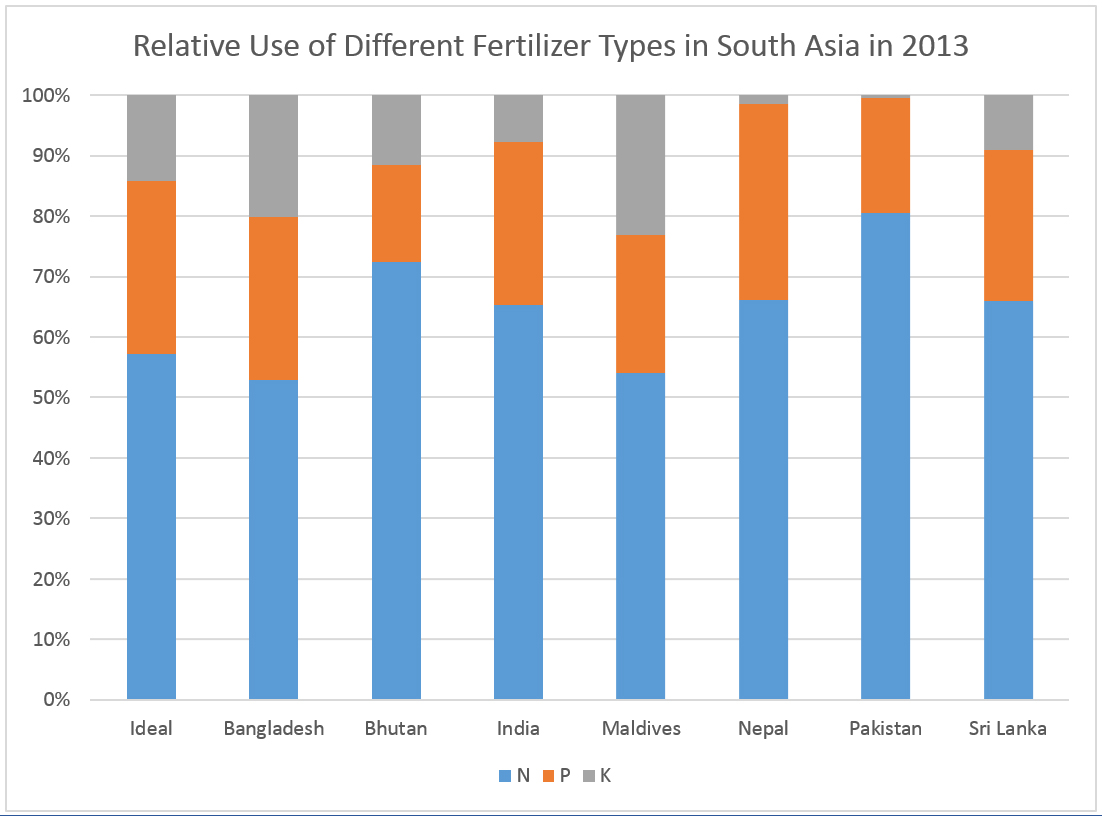edited by Hanzhou Yang
Since the Green Revolution in the 1960s to 1980s, which introduced high-yielding varieties of crops, improved fertilizer, irrigation, and pesticides to agriculture in developing countries, South Asia’s appetite for inorganic fertilizer has not stopped. In 2012-3, fertilizer consumption in this area accounts for 18 percent of the world’s total usage. India alone consumed 28.1 million tons of fertilizer in 2010, making it number two in the world, after China. However, farmers in South Asia do not use the appropriate ratio of nitrogen (N), phosphate (P), and potash (K) fertilizer that would increase their yields. Instead, the governments of South Asian countries subsidize the price of N fertilizer, creating incentives for misuse, while neglecting other minerals like P and K —threatening sustainable productivity and leading ultimately to negative consequences for food security within South Asian countries.

In India, for example, the extensive government subsidies and the excessive use of N fertilizer in agricultural production have driven decreasing or static yield responses to inorganic fertilizer in the past 10 to 20 years—results manifested in lower partial factor productivity (here the ratio of total output of cereal yield to N fertilizer inputs) than 100. For optimal yields and sustainable farming, the literature suggests to apply N, P, and K fertilizer in a ratio of 4:2:1. Looking at the distribution of fertilizer nutrients with data from FAOSTAT, the imbalance towards nitrogen is clearly visible in most countries in South Asia: the region’s overall ratio is 8:3:1 (Table 1). In 2013, all considered countries except Bangladesh (ratio 3:1:1) and the Maldives (ratio 1:1:2) consumed too much N and too little K (Figure 1), while the ratio for P almost reached adequacy. Long-time fertilizer experiments conducted on the use of N-rich inputs show that initial high productivity becomes unsustainable and decreases the yield in the long run if no other nutrients are added.

The trend of using too much N and too little K or P fertilizer is caused by economic incentives more than farmers’ lack of knowledge. P and K fertilizers are, on average, more expensive than N-based ones, and they are less effective judged on their value cost ratios, which measure “the ratio between the value of additional crop yield and the cost of fertilizer.” According to Mujeri et al., the value cost ratio of wheat for the N-rich fertilizer Urea in Nepal is 5.94, which is more than triple the ratio of P (1.59) or K (1.34) fertilizers. This might account for farmers’ overreliance on the cheaper and more effective N fertilizer that is subsidized by most South Asian governments.
The current distribution of subsidies does not take into account the ratios of fertilizers used by poor farmers—neither the optimal nor the widely-practiced ratios—but preserves the original considerations for providing incentives for farmers during the Green Revolution: the adaptation and use of new technology like fertilizer. The South Asian governments continue this outdated policy in order to ensure food security. Especially small-holder farmers with little capital rely on affordable fertilizer to be able to produce and to maintain their livelihoods. If the subsidies for N fertilizer were to be removed completely in India, to take one example, its price would increase by 69 percent and thus production of food grain would be reduced by nine percent. However, a focus on only one type of fertilizer contradicts the aim to improve productivity because the right ratio of different fertilizers—not an overuse—seems necessary to accomplish this goal. Instead of offering farmers the required support, the subsidy system claims an unsustainable large share of government expenditures and primarily benefits domestic industries producing N-based fertilizer. For instance, in 2011 fertilizer subsidies accounted for 11.9 percent of the total government expenditures in Bangladesh.
Adjustments to this regime are inevitable to sustain agricultural production and to avoid food insecurity in South Asia. Thus, governments with large industries, especially in Pakistan and India, should be encouraged to cut subsidies for the supply side. In India, for example, the government backs otherwise partly unprofitable industries for the production of Urea. Without the subsidy, this type of fertilizer could reach the real market price and disincentives would be overcome. However, the political feasibility of such a change is questionable, due to the weight and prestige of the large domestic production industry. On the demand side, all South Asian governments should promote agricultural extension that focuses on nutrient use efficiency, as well as site-specific nutrient management. A trial on 179 irrigated rice sites in Asia confirms the potential of site-specific nutrient management to improve nutrient efficiency and to close existing yield gaps.
Despite good intentions, the region’s governmental subsidies distort the fertilizer market and create incentives for the farmers to buy the cheaper and, in the short run, more effective N-based fertilizer. Therefore, due to misguided incentives created by market regulation, farmers act counter to their own best interests in their use of inorganic fertilizer by consuming too much N and too little P or K. Agricultural extension services about site-specific nutrient management have shown to be a good strategy to reemphasize effective use of fertilizer. A modified price strategy and the capacity-building of farmers could counteract wide-spread upside-down fertilizer practices and enhance the right use of fertilizer, which in turn would benefit the region’s agricultural productivity.
